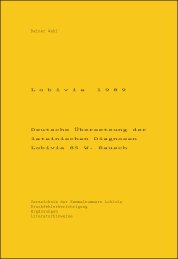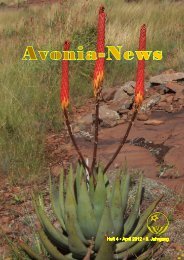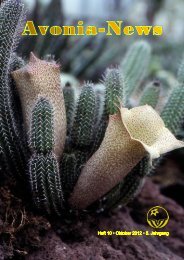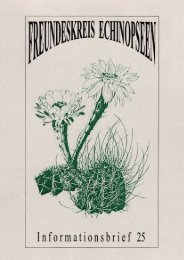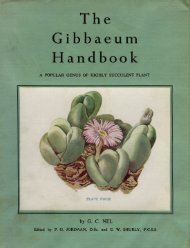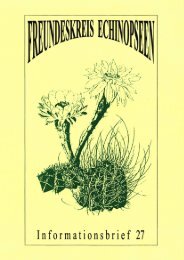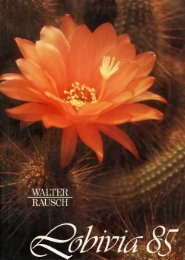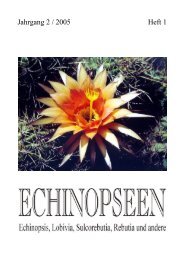VOLUME 14 :: January—October, 1952 Illustrations shown in ...
VOLUME 14 :: January—October, 1952 Illustrations shown in ...
VOLUME 14 :: January—October, 1952 Illustrations shown in ...
Create successful ePaper yourself
Turn your PDF publications into a flip-book with our unique Google optimized e-Paper software.
THE CACTUS AND SUCCULENT January, <strong>1952</strong><br />
CACTUS CULTURAL NOTES<br />
By A. BOARDER<br />
I have been asked by a member how the spirals are counted on Mammillarias. This question arises out of the<br />
descriptions <strong>in</strong> Craig's Mammillaria handbook, <strong>in</strong> which he shows that the spirals on these plants are arranged <strong>in</strong><br />
series, both <strong>in</strong> a clockwise and anti-clockwise fashion. They run from the top of the plant to the base, and if the<br />
plant is exam<strong>in</strong>ed from the top, the spirals will be seen quite easily. If a small piece of tissue paper is fixed to one<br />
of the tubercules as a guide, the plant can be turned round and the spirals counted back to the mark. Craig gives<br />
the number of spirals of most of the species of Mammillarias and states that they can be recognised by these numbers<br />
of spirals. This may be of some use when deal<strong>in</strong>g with mature plants <strong>in</strong> America, but I do not see that it can assist<br />
us very much <strong>in</strong> this country where so many of our plants are grown from seed. When I came to test the value<br />
of the spiral count I chose a Mammillaria rhodantha var. pfersdorffi which had been raised from seed by me from<br />
a parent plant raised from seed obta<strong>in</strong>ed <strong>in</strong> 1927 from Haage <strong>in</strong> Germany. Craig gives the plant, M. rhodantha<br />
as hav<strong>in</strong>g 13 one way and 21 the other. My seven-year-old plant from seed has 21 spirals one way and 34 the other.<br />
This caused me to exam<strong>in</strong>e the other plants I had raised from seed of the same variety and found that a one-year<br />
seedl<strong>in</strong>g showed no noticeable spirals at all, whilst a second-year plant from seed had 10 spirals. A five-year plant<br />
had 21 spirals. It is quite obvious to me that one cannot possibly expect to f<strong>in</strong>d the large number of spirals on the<br />
plants he describes on a small seedl<strong>in</strong>g Mam., and at what age the plant is expected to develop the necessary spirals<br />
by which it can be recognised we are not told. I consider that the rate of development of the spirals will depend<br />
on how quickly the plant matures. It certa<strong>in</strong>ly appears to me that the number of spirals are likely to <strong>in</strong>crease as<br />
the plant <strong>in</strong>creases <strong>in</strong> size, and I shall make a note of the plants <strong>in</strong> question to see if the spiral count changes.<br />
In the October issue of the Journal I gave a list of Cacti species suitable for a beg<strong>in</strong>ner and I now add a further<br />
list of different genera so that the grower can extend the range with other plants some of which are not so easy<br />
to grow or yet to acquire. I have raised from seed plants that are mentioned and so it is not impossible to obta<strong>in</strong><br />
these k<strong>in</strong>ds, although I must admit that some of them were grown before the war. They are : Ancistrocactus<br />
scheeri, Ariocarpus fissuratus, Aztekium ritteri, Bartschella schumannii, Cleistocactus straussii, Cochemia halei,<br />
Epithelantha micromeris, Frailea schil<strong>in</strong>zkyana, Harrisia bonplandii, Homocephala texensis, Lophophora williamsii,<br />
Mamillopsis senilis, Neobesseya missouriensis, Pelecyphora aselliformis, Selenicereus grandiflorus, Solisia pect<strong>in</strong>ata,<br />
Thelocactus bicolor, and Stenocactus lamellosus.<br />
Included <strong>in</strong> the above are a few plants which are more difficult to grow from seed than the previous plants<br />
mentioned, but with some care <strong>in</strong> the early stages it is quite possible to get reasonably-sized specimens <strong>in</strong> a year or<br />
two. The Mamillopsis senilis is a fairly quick grow<strong>in</strong>g k<strong>in</strong>d from seed but after about four years many of these plants<br />
seem to go wrong. Such plants as Epithelantha micromeris and Ariocarpus fissuratus are slow from seed and beg<strong>in</strong>ners<br />
will be well advised to let someone with more experience raise these for them ; the latter species is particularly<br />
slow from seed. In a later article I shall give a few more uncommon ones and gradually deal with some fresh<br />
species of some of the Genera mentioned.<br />
I promised <strong>in</strong> the previous Journal to give a complete guide to grow<strong>in</strong>g Cacti from seed. I know that I have<br />
dealt with this subject before, but I get so many enquiries on this subject that I feel sure that it will be well worth<br />
while to deal with seed rais<strong>in</strong>g once more. Most growers f<strong>in</strong>d it difficult to believe that I can get my seedl<strong>in</strong>gs<br />
to grow as quickly as I do, and the plants which I usually take with me to a meet<strong>in</strong>g of the Society are exam<strong>in</strong>ed, as<br />
a rule, with amazement, and I am always accused of hav<strong>in</strong>g blown them up with a bicycle<br />
pump. I was able to tell the members at the meet<strong>in</strong>g on November 6th, that I now had another pump ; one which<br />
blew the flowers on them as well. This because I showed a Mammillaria rettigiana plant which had been raised<br />
from seed sown <strong>in</strong> February this year which was already <strong>in</strong> prom<strong>in</strong>ent flower bud. S<strong>in</strong>ce that meet<strong>in</strong>g I have<br />
noticed a seedl<strong>in</strong>g, sown at the same time, of At schiedeana, which also shows two flower buds.<br />
This proves once aga<strong>in</strong> that it is not the long w<strong>in</strong>ter's rest which assists the formation of flowers, nor be<strong>in</strong>g<br />
pot-bound. It ties up with my constant rem<strong>in</strong>der that a plant will flower if it is grown well. I notice that an<br />
article on rais<strong>in</strong>g Cacti from seed was published <strong>in</strong> the March Journal of 1933, be<strong>in</strong>g a resume of a talk I gave to<br />
the Society, and a photograph of a number of my seedl<strong>in</strong>gs was published at the same time. It is <strong>in</strong>terest<strong>in</strong>g to<br />
note that my methods have not changed very much s<strong>in</strong>ce then, but it is surpris<strong>in</strong>g that as I have been regularly<br />
giv<strong>in</strong>g away my methods s<strong>in</strong>ce that time there are so many members who say that they cannot get anywhere near<br />
the same rate of growth. I am at a loss to know why this can be and to clear up any doubts once and for all I will<br />
give now the exact method which I use, and then if this is carried out there is no earthly reason why everyone<br />
else should not be able to grow Cacti from seed equally as well.



